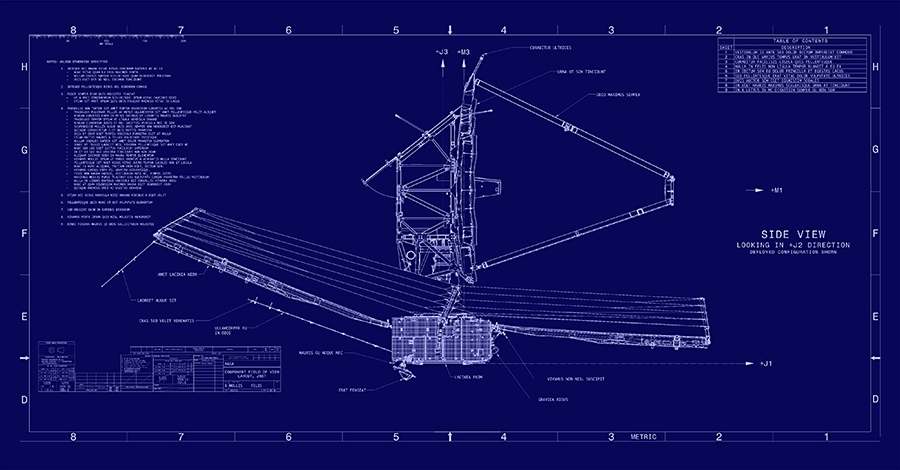- Launched in 2021, the James Webb Space Telescope (JWST) has already sent home breathtaking images that have inspired the public and intrigued astronomers.
- Research Features caught up with Nobel Prize-winning astrophysicist John C Mather, Senior Project Scientist for the James Webb Space Telescope, Senior Astrophysicist at the Observational Cosmology Laboratory at NASA’s Goddard Space Flight Center, and Goddard Senior Fellow.
- Read on to find out why the edges of space are beyond our imagination, what the JWST has already discovered, and what it might be like to live on Mars.
The James Webb Space Telescope (JWST) is detecting stars formed in our Universe’s infancy. Do you think you have found the very first stars?
Not yet! We’re hoping to find them, but it’s very hard to tell whether the stars we see are really formed from primordial material or whether they were born from debris of previous generations of stars. Estimates suggest what we are looking at was formed around 150 million years after the Big Bang – but our information is very preliminary right now.
The Universe can do whatever it is set up to do, but our imagination doesn’t always keep up. It’s hard to imagine infinity, because it’s not a thing itself, but space keeps on going and going and going, and there’s no edge to the Universe that we’re aware of. If you imagine going back in time and getting closer to the first objects in the Universe, you get to where the temperatures and pressures are immense, and there are no objects to look at. The gravitational forces are so strong that we think quantum mechanics should apply to space and time themselves. It’s a giant hodgepodge, and we don’t really know what to call it. That’s the end of our imagination.

What have you learned about Jupiter and Neptune from the incredible infrared JWST captures?
Well, we want to know more about our little home here on Earth and understanding all of the planets in the solar system is part of that. One of the tricky things about our subject is that we imagined that there must be millions and billions of planets because most stars seem to have them. However, we have not found any systems that look like the solar system, with four little rocky planets in the middle, four giant planets much farther out, and a little gap for asteroids. What can the giant planets tell us about the history of our own solar system? What are the molecules in them? It looks like our oceans were filled up long after the Earth itself was formed, probably by comets and asteroids from Jupiter and beyond. That means we have to study our outer solar system with all the tools we have. It’s also beautiful to look at. Jupiter has an aurora at the north and south pole. Uranus and Neptune have brightly glowing clouds, and they all seem to have rings around them. Every pretty picture is a puzzle for us.
Are you able to give us a sneak peek into exciting JWST missions that will be happening in 2023?
We have a large catalogue of things we look at every week and we ask our worldwide community of astronomers to send us proposals every year. We recently took data on nearby planets like the TRAPPIST-1 system, a system of seven planets, and three of them could be about the right size and temperature to be like Earth. Do those little planets have an atmosphere? And if they do, is there any sign of molecules such as water?

Another huge question is whether there are forms of life that aren’t based on carbon and water like we are. Everybody knows Mars might have been alive because it seems to have been wet a long time ago. There are several other places that are wet right now, including the moons of the giant planets. Europa, satellite of Jupiter, has an ocean covered with ice. There are cracks in the ice, and sometimes water comes spitting out. We’d like to know what’s in that water. NASA will be sending a probe to fly through the water clouds to see whether there is any sign of molecules that might be organic and tell us about that water underneath.
We’ll also be sending a probe to Titan, a very large satellite of Saturn, so large that it has its own thick atmosphere. We want to see what the surface is like in different places. What we know so far is that there are rocks made of water ice and there are clouds, rain, lakes, and rivers made of hydrocarbons like ethane and methane. This is a remarkable place to go looking if you think life might be based on some other system besides ours.
What can the giant planets tell us about the history of our own solar system?

With George Smoot, you discovered vital evidence for the Big Bang Theory and, in 2006, were awarded the Nobel Prize in Physics for this work. Could you tell us about your ground-breaking Cosmic Background Explorer mission (COBE-project)?
NASA held a competition in 1974 for new satellites to follow on after the moon landings, and I had just finished graduate school. My thesis project was an attempt to measure the cosmic microwave background radiation, which is the heat left over from the early Universe. The thesis project actually didn’t work the first time, but I knew I wanted to try it in outer space. NASA thought this was interesting; we got started seriously and in 1989, after numerous challenges, we launched it. We discovered two things right away. The first one was that the Universe has the right spectrum, that is to say brightness at each wavelength, to match the predictions of the expanding universe theory – that the radiation left over from the earliest moments has had its wavelengths stretched as the Universe expanded, creating the cosmic background radiation spectrum we see today. Then, a couple of years later, we measured hot and cold spots in a map of this heat radiation.
Measuring very tiny variations of that temperature was a huge technical accomplishment. We found out that most of the spots are due to cosmic dark matter, which is invisible – but we know it’s there because of its gravity, and the pattern is affected by cosmic dark energy, which also cannot be seen, but it affects the rate of expansion of the Universe. There is now a standard model that fits all these data very well, accounting for how the whole Universe functions at a massive, cosmological scale. I never would have guessed when we first proposed making a measurement that we’d find these things and more. Thousands of astronomers have been working on these maps of hot and cold spots ever since we found them.

Could you please tell us a little bit about the ‘starshade’ you’re working on?
One of the hardest problems in astronomy is to take pictures of exoplanets – planets outside of our solar system – orbiting other stars. Because the stars are so bright, the planets appear very faint and dim. Until now, only a handful of exoplanets have been photographed. We (I should say Europeans) are building a telescope in Chile which is six times as big as the Webb. The ‘starshade’ can then be positioned between this telescope and the star; the idea is to put up something in space to cast a shadow of the star onto the telescope on the ground. We then might be able to see and photograph the smaller exoplanets. The biggest challenge right now is to make such a starshade that is big, 100m across, but lightweight. We are running competitions to get students involved, and so far we’ve had about 50 designs submitted to us.
This is a wonderful time to be an astronomer because we have so much new information coming in.
How do you get young people involved with all this?
It’s remarkable how little control scientists have directly over this; the media on the other hand has a big effect. The popular television programme ‘The Big Bang Theory’ led to twice as many physics students as we had before it aired. Nowadays, off the back of the Webb Telescope images coming out, the numbers of astronomy students are jumping. The way we reach the public is not always the way you might think. After I saw the movie ‘The Martian’ I thought, now people want to go to Mars and are enthusiastic enough to make it happen! It’s not impossible, it’s just really hard. So the media has a huge effect on all of us.
I went to the Intel International Science and Engineering Fair a couple of times, where 2,000 people from around the world are showing off their coolest project. A pretty large fraction of these young people are working on climate change and energy supply. They’re working hard on things that are making a huge difference to life on Earth. Some people get scared, others say ‘This is a challenge, and I’m going to fix it!’.

Do you think that people living today will see people living on Mars?
We’re not yet able to come home from Mars; we can get you there and we can send you food forever, but we can’t get you home because we don’t have fuel on Mars to get you back off the surface. I think we will have people living on Mars though. I don’t think there are going to be very many of us there, mind you. It is too hard to get there, and it will be too unpleasant living in a small school bus with 10 or 20 people for the rest of your life. It won’t be much fun unless you’re pursuing something of deep interest, something that makes it worth all that discomfort.
How do you envision space science, travel, and technology evolving in the future?
Is there life elsewhere? Probably yes. There are so many places that it could be and there’s no reason to think that Earth is unique. Other astronomers have already declared that what they want to try first is another telescope in space that’s about as big as the Webb, but more perfect! It would be able to see those little Earths orbiting stars like the Sun, and look for signs of life, like oxygen. Some people have been working on solutions from space for climate change (like protecting the Earth from the Sun by putting up things that block some sunlight in orbit), but I think it’s more likely that we will get solutions from here on Earth. Some people want to terraform Mars. I think it’s more important to terraform Earth and keep it friendly to civilization. Right now we can see that technology is changing on a daily basis, with artificial intelligence becoming useful, robots helping us with more and more projects, and new ways to power the world electrically. The straightest path to nuclear fusion power is solar energy; the Sun is a perfect reactor already, and we have free power distribution every day.
If you had a message for any aspiring astronomers, what would that message be?
I would say this is a wonderful time to be an astronomer because we have so much new information coming in and so many possible discoveries. And you, young astronomer, could be one of them!










